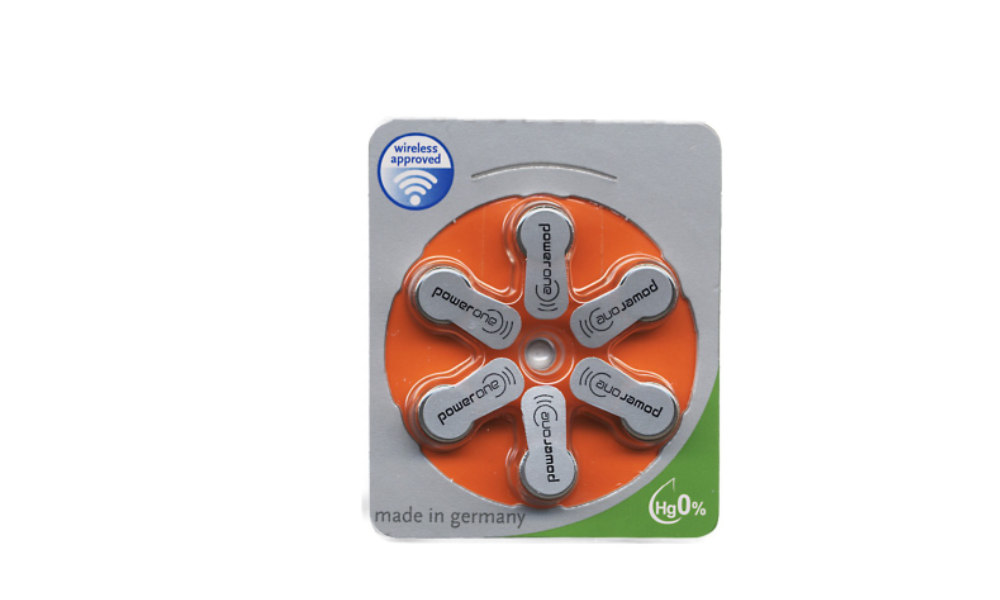One of the most critical components affecting the performance of a hearing aid is the battery. Hearing aids on the market today are commonly powered by a disposable zinc-air button battery or a lithium-ion rechargeable battery.
Disposable button batteries
Zinc-air button batteries come in a variety of sizes. Generally the size of the hearing aid determines the size of the battery. Smaller hearing aids have smaller batteries that need to be changed more frequently, while larger or more powerful hearing aids have a bigger battery that can last up to 2-3 weeks. How often you would be prepared to change the battery in your hearing aids is something to consider when choosing a hearing aid.
Hearing aid battery sizes are standard across all manufacturers. It doesn’t matter which brand your hearing aid or your batteries are, any battery that is the correct size will work in your hearing aids. Batteries come in size 10, 312, 13 or 675. To make it a bit easier to differentiate between batteries, they are also colour coded.
- 675 Blue
- 13 Orange
- 312 Brown
- 10 Yellow
The chemical reaction in zinc-air batteries that give your hearing aids power is activated by oxygen entering the battery. This is why there is a seal on each individual battery. Once the sticker is peeled off the battery, the reaction is initiated and continues until it is depleted. It doesn’t matter whether you have used your hearing aids or not once a new battery is inserted, after some time the reaction will be exhausted and the battery will no longer work. To get the most out of your battery, keep the sealed battery in its packet until you are ready to use it and then wait a few minutes after peeling the sticker off before inserting the battery into the hearing aid.
The batteries also become less effective over time even when they are sealed. There is an expiry date on each packet of batteries. It is commonly on the back of the packet in the yyyy-mm format near the lot number of the packet. If your packet of batteries is near expiry, you might notice that the batteries run out faster and need to be changed more frequently.
Rechargeable batteries
Previously, rechargeable hearing aids were limited to the top tiers of technology and were less common than disposable zinc-air batteries. At present, there is a rechargeable option available through every manufacturer at different price points. Some hearing aids are powered by a silver-zinc rechargeable battery that has a lifespan of approximately one year. The latest rechargeable hearing aids contain a lithium-ion rechargeable battery just like a mobile phone which can last between 2-5 years.
Lithium-ion rechargeable hearing aids have the advantage of being easier to maintain than disposable batteries. If you have difficulty handling small objects with your fingers or concerns about your vision not being good enough to change a tiny disposable battery, a lithium-ion rechargeable hearing aid is a better option for you. The hearing aid can be inserted into the charger at night and simply taken out of the charger in the morning and put straight into your ear.
A common concern about rechargeable hearing aids is what to do if the hearing aid runs out of battery and there is no power source available for charging. Lithium-ion rechargeable hearing aids are designed to last the whole day and often don’t run out of battery during the day. If you are streaming music and phone calls through your hearing aids for most of the day, the battery may run out faster. Some manufacturers have a power pack integrated into the charging case or can be purchased as an attachment which can allow you to charge your hearing aids multiple times before needing to plug it into a power source. Alternatively, you can carry your charger with you with its USB cable and plug it into your car or laptop during the day. As the battery charges quite fast, you can charge the hearing aids for half an hour or so and will be able to use your hearing aids for a few hours longer.
Where do I get batteries?
If your hearing aids are funded through the Government’s Hearing Services Program, your batteries are covered by your maintenance agreement and available through our hearing clinic. You can ask for them over the counter at any of our clinics or can receive them by post if you phone our clinic and request a supply to be posted to you.
If you are having problems charging your lithium-ion rechargeable hearing aid, it most likely needs to be sent back to the manufacturer in order to have the battery checked and replaced. Some lithium-ion batteries can be replaced in the clinic if we have stock available. Please phone one of our hearing clinics to find out the best course of action for any issues you are having. We may be able to loan you a hearing aid while yours is away for repair.
Feel free to arrange a no-obligation appointment with one of our clinicians to discuss the best hearing solution for your personal listening needs.

